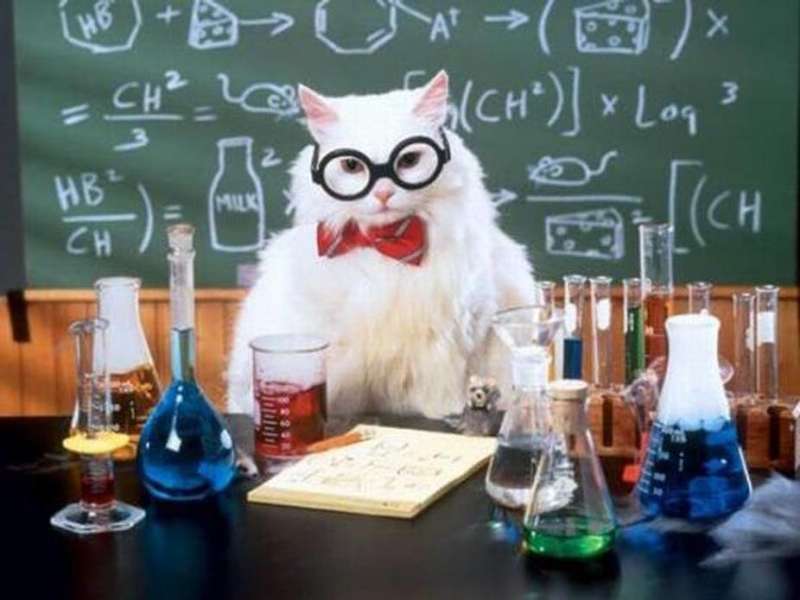Chemistry Cat’s got some knowledge for you. Credit: Know Your Meme
There's never a dull moment on the internet, and that's got a lot to do with the fact that the content shared online is constantly changing – thanks in part to the creativity of users who remix, parody or caption popular images or videos, to create memes.
Punchy and humorous, memes are the perfect fodder for an internet culture shaped by viral sharing and creative participation. They may seem basic, but from a linguistic point of view, they're surprisingly sophisticated. Meme creators use "multimodal grammar" (in other words, images and captions) to express and share ideas and opinions. By tagging their friends in memes shared on social networks, people add their own personal meanings to the content.
Despite their popularity, it's not widely known that the meme has its origins in the world of academia. The term "meme" is rooted in evolutionary biology, and was coined by Richard Dawkins in his famous 1976 book, The Selfish Gene. According to Dawkins, a meme is "a unit of cultural transmission or imitation": his examples include the concept of God, nursery rhymes and jokes, catchphrases and fashion trends.
The word comes from the Greek "mimema", meaning imitated, which Dawkins supposedly shortened to rhyme with gene; a nod to the similarities between the survival of certain memes through the evolution of culture, and the survival of certain genes through the process of natural selection.
Going viral
Internet memes, as we know them today, are units of popular culture that are circulated, imitated and transformed by users. Limor Shifman, a key scholar in the study of internet memes, argues that a meme is not a single idea or image which is spread across social sites, but a group of items that were created with awareness of each other. For example, the famous Grumpy Cat meme is not the cat himself, but the whole set of memes generated with his image.
The first meme on the internet was actually the sideways "smiley" – :-) – created in 1982 by American computer scientist Scott E. Fahlman. The practice of using punctuation markers to show emotion was quickly picked up by internet users all over the world, and several other expressions, such as :-( and ;-), were added to the repertoire of the "emoticon" meme.
In 1998, when the web was enjoying more mainstream use, the Hampster Dance meme – depicting rows of dancing hamster GIFs, on the website of Canadian art student Deidre Lacarte – became popular. By the end of June 1999, the site had been visited 17m times. It later spawned a catchy song by the Cuban Boys and a viral remix by Hampton the Hamster, as well as several copycat sites. This meme, as simple as it may be, is one of the first examples of viral digital content.
Next gen memes
New breeds of memes emerged in the second half of the naughties, alongside the proliferation of pet photos shared online. The well-known examples were Advice Dog, LOLCats and Grumpy Cat. Animals with human characteristics have long been a part of human culture – from ancient Egyptian gods to children's stories such as Peter Rabbit – so it's hardly surprising to see them revived in the digital era as memes.
Starting from the late naughties, memes began to feature celebrities and ordinary people. Examples include Charlie Bit My Finger, Kanye Interrupts, Leave Britney Alone and Cash Me Ousside/How Bah Dah. These memes all came from a media event or a viral video, which agile internet users parodied, imitated, remixed and mashed up.
Memes are also used by people to promote certain political ideas or ideologies. Pepe the Frog, for example, was appropriated from the comic series Boy's Club by the alt-Right, ultimately becoming a racist symbol before being killed off by his creator Matt Furie.
Using websites such as Meme Generator, people can use the biting humour of memes to try to delegitimise the arguments and leaders of rival political movements. This kind of activity ramped up around major political events such as the US and UK elections – and met with varying degrees of success.
Memes will continue evolving, along with the advances and changes in digital communication. Yet one thing that remains the same is humans' desire to connect with one another and create a shared culture. Trivial as they may seem, memes contribute to this shared culture by fostering people's imagination, creativity and involvement in society through new media.
Provided by The Conversation
This article was originally published on The Conversation. Read the original article.![]()
























